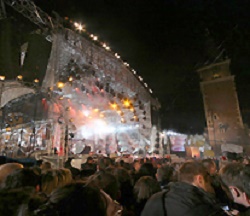
Velocity & Time
So, if all that was not complex enough, the clincher is that the speed of sound is not constant. As the air gets hotter, sound travels faster. In increasingly humid environments, sound travels faster. And when air is denser, as it is at lower altitudes, sound travels faster. Faster, faster, faster.
That means a rock show on the beach in the equatorial humid heat of Costa Rica is going to have sound possibly 8 percent faster than a show in the Swiss Alps with sub-zero temperature and little to no humidity.
It would seem that even with the various thermal layers in a large venue, the small variances in velocity would not matter much, except for perhaps recalibrating delay cluster times.
For the direct sound from a loudspeaker to your ears, it really does not matter much. What does matter is what happens when the direct sound combines with indirect sound that has bounced off of a wall or other surface.
Earlier in the day, in the cool empty room, much time was spent analyzing and equalizing with complex test equipment to create a flat smooth response.
Then here comes the humans – heating, steaming and filling the room, causing a speeding up of the sound waves. Now all the sound waves are arriving sooner, and the ones that traveled the farthest gain more time than the ones that traveled shorter distances.
As such, frequencies that earlier in the day combined in phase, may now combine out of phase and the faster speed of sound has wreaked havoc on the system EQ. But that’s not the only issue accelerated sound speed causes.
Imagine an outdoor concert with cool night air lying atop thousands of warm dancing humans. This is called an inversion layer; hotter air below, colder air above. Sound waves projected by the loudspeakers travel at a slower speed through the cool air down toward the heat.
As the lower parts of the sound waves enter the heat, they are accelerated to the faster warmer humid sound wave velocity, causing them to refract upwards. This thermal phenomenon of sound waves bending or refracting is similar to what causes light to form a mirage in the desert heat. Increases in the angle of incidence reduce the negative effects of the refraction.
The Bigger Picture
All in all, warmer and neutrally humid environments tend to be the way to go for a memorable adventure. Cold is drafty, sterile and often crisp and edgy sounding.
In my opinion, the hotter liquid atmosphere of a muggy rock show not only speeds up and tames the sound; it also seems to enhance that connection between the performers and those immersed in the performance.

